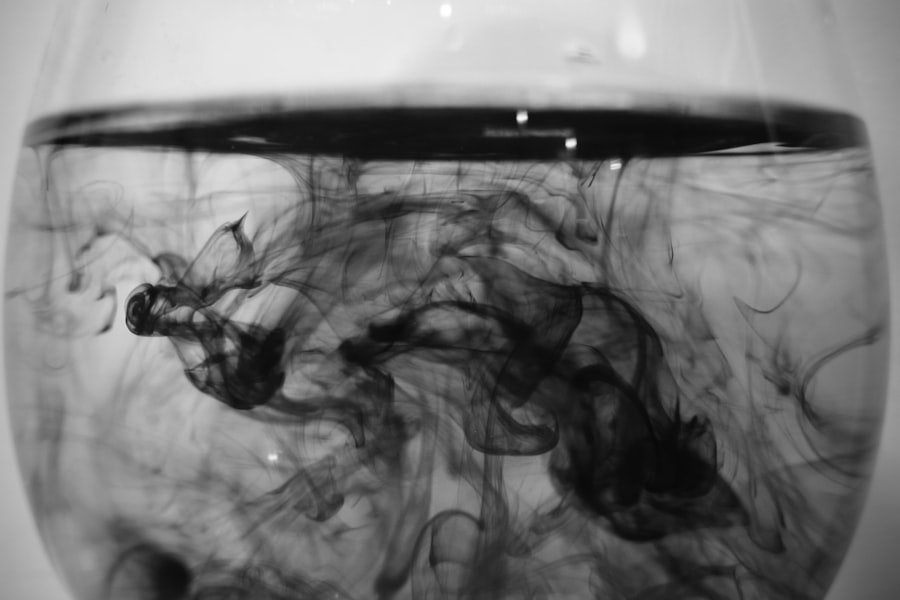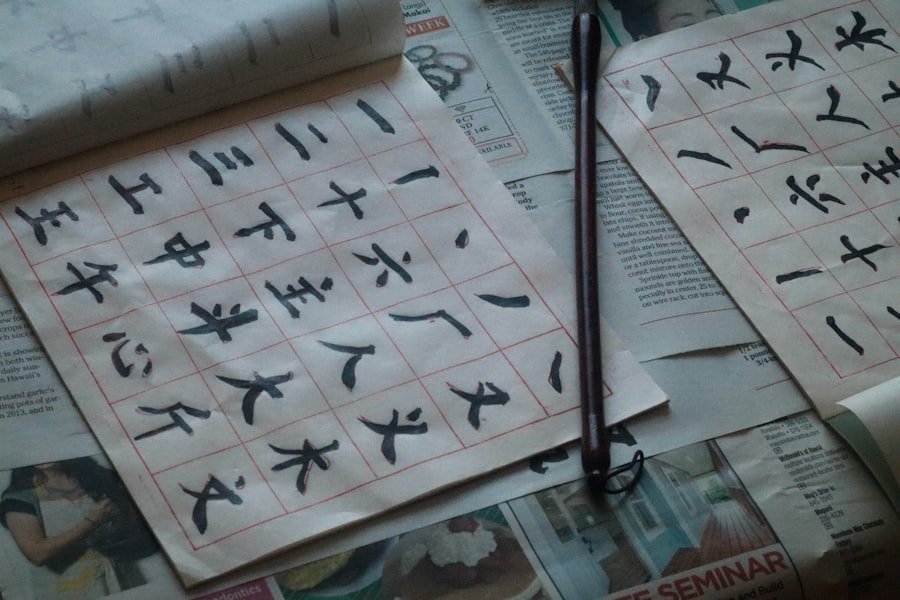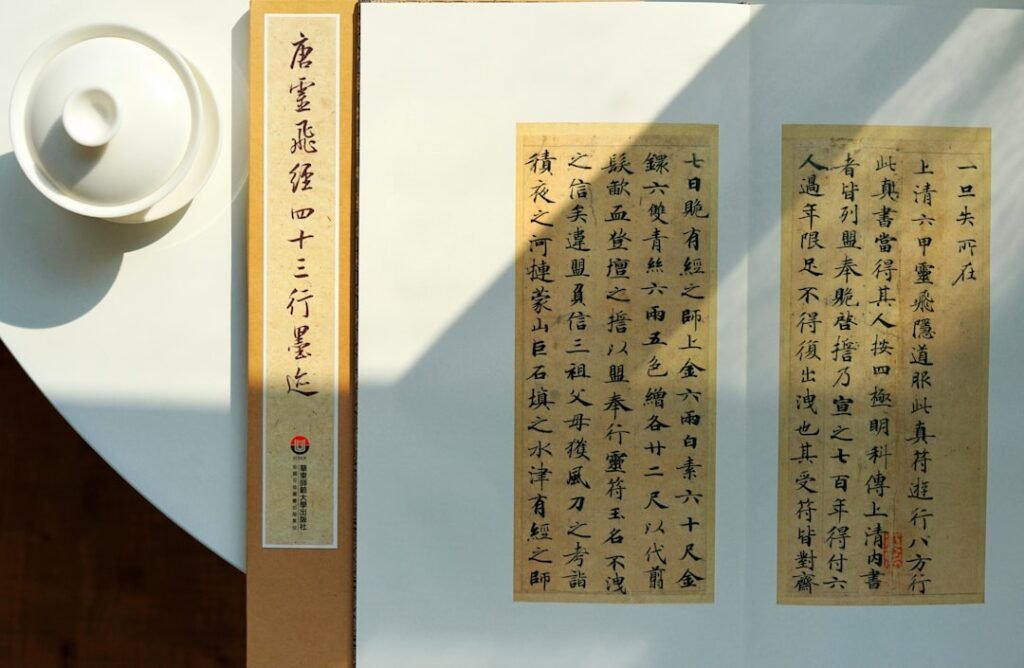Chinese calligraphy is not merely an art form; it is a profound expression of culture, philosophy, and emotion. At its core, the principles of Chinese calligraphy revolve around the harmonious interplay of brush, ink, and paper. Each stroke is imbued with meaning, reflecting the character of the calligrapher and the essence of the words being inscribed.
The practice is steeped in tradition, with roots tracing back thousands of years, and it serves as a bridge connecting the past with the present. Understanding these principles is essential for anyone wishing to delve into this intricate art form. The philosophy behind Chinese calligraphy extends beyond aesthetics; it embodies a way of thinking and being.
Calligraphers often draw inspiration from nature, philosophy, and their own emotions, allowing these elements to influence their brushwork. The balance between structure and spontaneity is crucial, as each character must convey its meaning while also adhering to the rules of form and style. This duality is what makes Chinese calligraphy a unique blend of discipline and creativity, inviting practitioners to explore their inner selves while mastering the technical aspects of the craft. Master the art of Chinese calligraphy. Enroll now at the LC Chinese School in Oslo.
Table of Contents
ToggleSummary
- Understanding the principles of Chinese calligraphy is essential for mastering the art form.
- Analysing basic strokes and techniques is crucial for developing a strong foundation in calligraphy.
- Evaluating composition and balance is important for creating visually appealing and harmonious characters.
- Assessing consistency and fluidity of brushwork is key to achieving a polished and professional look in calligraphy.
- Critiquing the use of space and proportions is necessary for creating well-balanced and aesthetically pleasing characters.
Analysing the Basic Strokes and Techniques
To truly appreciate Chinese calligraphy, one must first analyse the basic strokes that form the foundation of this art. Each character is constructed from a series of strokes, each with its own name and significance. For instance, the horizontal stroke (heng) represents stability, while the vertical stroke (shu) signifies strength.
Understanding these strokes is akin to learning the alphabet in a new language; they are the building blocks that allow one to create more complex characters. Techniques in Chinese calligraphy vary widely, influenced by regional styles and personal preferences. The use of different brushes can dramatically alter the outcome of a piece, as can the choice of ink and paper.
Practitioners often experiment with various tools to discover what best suits their style. Mastering these basic strokes and techniques requires patience and practice, as each stroke must be executed with precision and intention. As one becomes more familiar with these elements, the ability to express oneself through calligraphy begins to flourish.
Evaluating the Composition and Balance

Composition in Chinese calligraphy is an art in itself, requiring careful consideration of how characters are arranged on the page. A well-composed piece not only showcases individual characters but also creates a sense of flow and harmony throughout the work. The placement of each character can evoke different emotions and responses from the viewer, making it essential for calligraphers to evaluate their compositions critically.
Balance is another key aspect of composition in Chinese calligraphy. It involves not only the visual weight of characters but also their relationship to one another within the space. A piece that appears unbalanced can disrupt the viewer’s experience, while a harmonious arrangement invites contemplation and appreciation.
Calligraphers often strive for a dynamic equilibrium, where each character complements its neighbours, creating a cohesive whole that resonates with both beauty and meaning.
Assessing the Consistency and Fluidity of the Brushwork
Consistency and fluidity are vital components of effective brushwork in Chinese calligraphy. A skilled calligrapher demonstrates a seamless flow between strokes, creating a sense of movement that captivates the viewer. This fluidity is achieved through practice and an understanding of how to manipulate the brush to achieve varying thicknesses and textures in each stroke.
Assessing one’s brushwork involves a critical eye for detail. Are the strokes uniform in thickness? Is there a natural rhythm to the way they flow together?
These questions are essential for identifying areas for improvement. A consistent style not only enhances the aesthetic appeal of a piece but also reflects the calligrapher’s mastery over their tools. As practitioners refine their skills, they learn to embrace both precision and spontaneity, allowing their unique voice to emerge through their brushwork.
Critiquing the Use of Space and Proportions
The use of space in Chinese calligraphy is as important as the characters themselves. Negative space—the areas around and between characters—plays a crucial role in defining the overall composition. A well-considered use of space can enhance readability and create visual interest, while poor spacing can lead to confusion or clutter.
Calligraphers must develop an acute awareness of how space interacts with their work, ensuring that each character has room to breathe. Proportions also play a significant role in effective calligraphy. Each character has its own unique structure, and understanding how to maintain proportionality is essential for creating aesthetically pleasing work.
This involves not only scaling characters appropriately but also considering their relationship to one another within a piece. A keen eye for proportions allows calligraphers to create works that are not only visually striking but also harmonious in their overall design.
Examining the Harmony and Rhythm of the Characters

Harmony in Chinese calligraphy refers to the way characters interact with one another on the page. Each character should not only stand out on its own but also contribute to a greater sense of unity within the composition. This harmony can be achieved through careful consideration of stroke style, size, and spacing, allowing each character to resonate with its neighbours.
Rhythm is another critical aspect that influences how viewers engage with a piece of calligraphy. The rhythm created by varying stroke lengths and styles can evoke different emotions and responses from those who observe it. A piece that flows smoothly invites contemplation, while one that features abrupt changes may provoke surprise or intrigue.
Calligraphers must be attuned to these elements as they create their work, ensuring that both harmony and rhythm are present in their compositions.
Identifying Strengths and Weaknesses in Your Work
Self-assessment is an invaluable tool for any aspiring calligrapher. Identifying strengths in one’s work can bolster confidence and encourage further exploration of those successful elements. Perhaps a particular stroke or character resonates well; recognising this allows practitioners to build upon their successes and incorporate them into future pieces.
Conversely, acknowledging weaknesses is equally important for growth. Whether it be inconsistent brushwork or awkward spacing, identifying areas for improvement provides a roadmap for development. This process requires honesty and humility, as it can be challenging to confront aspects of one’s work that may not meet personal standards.
However, embracing both strengths and weaknesses fosters a deeper understanding of one’s style and capabilities, ultimately leading to greater mastery of the art form.
Seeking Feedback from Experienced Calligraphers
Feedback from experienced calligraphers can be an invaluable resource for those looking to improve their skills. Engaging with mentors or peers who have honed their craft can provide fresh perspectives on one’s work. Constructive criticism can illuminate blind spots that may have gone unnoticed during self-assessment, offering insights into areas that require attention.
Moreover, seeking feedback fosters a sense of community among practitioners. Sharing work with others creates opportunities for dialogue about techniques, styles, and personal experiences within the art form. This exchange not only enriches one’s understanding but also cultivates relationships that can inspire continued growth and exploration in Chinese calligraphy.
Setting Clear Goals for Improvement
Establishing clear goals is essential for any artist seeking to advance their skills in Chinese calligraphy. These goals should be specific, measurable, achievable, relevant, and time-bound (SMART). For instance, a goal might involve mastering a particular style or technique within a set timeframe or completing a series of pieces that explore different themes or concepts.
Setting goals provides direction and motivation for practice sessions. It encourages practitioners to focus their efforts on specific areas rather than becoming overwhelmed by the vastness of the art form. As progress is made towards these goals, individuals can celebrate their achievements while remaining mindful of areas that still require attention.
Practising Regularly and Implementing Feedback
Regular practice is fundamental to mastering Chinese calligraphy. Consistency allows practitioners to refine their techniques and develop muscle memory essential for executing strokes with precision and fluidity. Establishing a routine that incorporates both focused practice on specific techniques and free exploration can yield significant improvements over time.
Implementing feedback received from experienced calligraphers further enhances this practice routine. By actively working on identified weaknesses or experimenting with suggested techniques, practitioners can accelerate their growth and deepen their understanding of the art form. This iterative process—practising regularly while integrating feedback—creates a dynamic learning environment that fosters continuous improvement.
Reflecting on Progress and Making Adjustments to Your Practice
Reflection is a crucial component of any artistic journey, allowing practitioners to assess their progress over time. Taking moments to evaluate completed works can reveal patterns in development—what has improved, what remains challenging, and how personal style has evolved. This reflective practice encourages mindfulness about one’s artistic journey and fosters a deeper connection with the craft.
As practitioners reflect on their progress, they may find it necessary to make adjustments to their practice routines or goals. Perhaps certain techniques require more attention than initially anticipated or new interests have emerged that warrant exploration. Being flexible in one’s approach allows for growth in unexpected directions while maintaining focus on overall improvement.
For those eager to immerse themselves in this captivating art form, LC Chinese School in Oslo offers exceptional courses in Chinese calligraphy tailored for all skill levels. These courses provide an opportunity not only to learn from experienced instructors but also to engage with fellow enthusiasts who share a passion for this ancient practice. The school’s supportive environment fosters creativity while emphasising traditional techniques essential for mastering calligraphy.
In conclusion, Chinese calligraphy is an intricate blend of technique, philosophy, and personal expression that invites practitioners on a journey of self-discovery through art. By understanding its principles, analysing strokes, evaluating composition, seeking feedback, setting goals, practising regularly, reflecting on progress, and embracing community support at institutions like LC Chinese School in Oslo, individuals can cultivate their skills while celebrating this timeless tradition.
Master the art of Chinese calligraphy. Enroll now at the LC Chinese School in Oslo.







